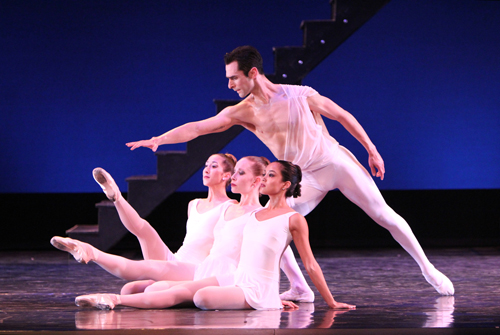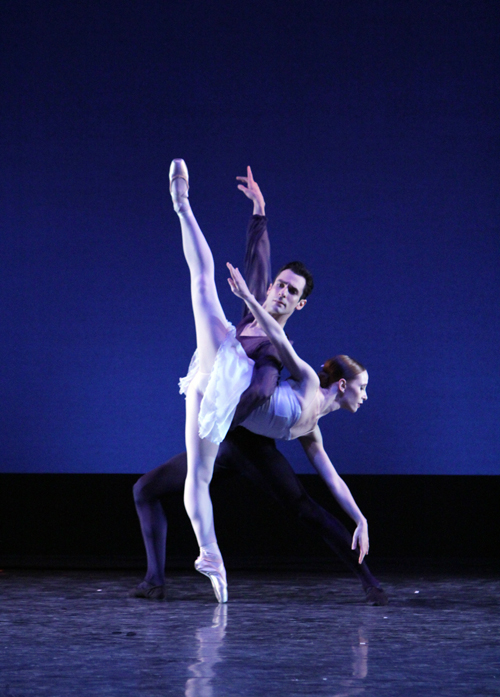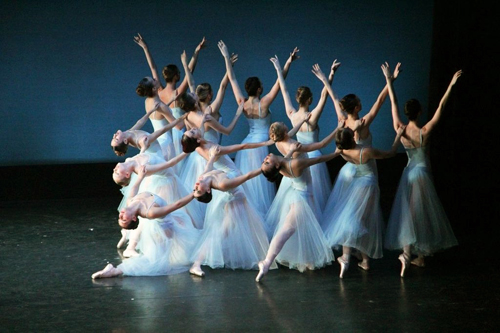By Sheila Orysiek

SAN DIEGO — The program of “Balanchine Masterworks” presented by City Ballet of San Diego at the Spreckels Theatre, on March 9, is evidence of the Company’s expanding repertoire of ballets choreographed by George Balanchine. Each addition to this treasure trove, which is carefully guarded by The Balanchine Trust, is an indication of technical and artistic maturity.
Not only does a Trust representative come to assess the ability of the Company to take on each ballet, but the representative also assesses the capability of each dancer, the venue, staging, and production values. The intent is to present, as closely as possible, how these ballets were danced during Balanchine’s lifetime. Choreography is a fragile art easily changed and corrupted; permission to dance this repertoire is not easily gained.
“Apollo” was first presented in Paris in 1928 and was the ballet which announced the presence of a major choreographic talent. It was also the beginning of Balanchine’s life long love affair with the music of Igor Stravinsky. During his lifetime, Balanchine often added and subtracted from this ballet, particularly the opening segment – the birth of Apollo. City Ballet wisely dances this work in its entirety which gives meaning and context as the god is born, stumbles as he realizes his role and then grows before our eyes into the power that is his birthright.
Geoff Gonzalez, both as a dancer and as Apollo makes this role his own. He does indeed show the wonder of his inner godhood as it grows and he becomes adept at using it. The three muses, Ariana Samuelsson, Erica Alvarado and Kyndra Ricker, all danced with grace, but it was Gonzalez/Apollo who showed the way to where the gods dwell.

Choreography by George Balanchine
©The George Balanchine Trust
girls left to right: Kyndra Ricker, Ariana Samuelsson, Erica Alvarado”
Photo: Chelsea Penyak
“Allegro Brillante” to Tchaikovsky’s music is the newest addition to the Company’s Balanchine repertoire. Erica Alvarado and Stephano Candreva did well as the leads, the dancing by everyone was fresh and crisp – negotiating the quicksilver choreography with style. But, I thought this ballet belonged to the men: Trystan Loucado, Carlo Di Dio, Derek Lauer, Ryosuke Ogura and Candreva. When dancing together, it is particularly difficult for men to truly coordinate their dance vocabulary of jumps and turns. The timing and energy is so different for each dancer; speed of rotation, height and breadth of each jump (whether small or large). And yet, this they did to perfection.
Using Ravel’s music, “Sonatine” is a light piece which Ariana Samuellson and Geoff Gonzalez negotiated with ease. Accompanied onstage by pianist Nina Flowers, the dancers pause to consider the opening bars of music and then let it dance through them. Both dancers – as Balanchine often expressed it – made the music visible. Though well lit by Stephen Judson, and though choice of costuming is stipulated, still I do dislike black (used mostly for the male dancer) against a black back drop.

Choreography by George Balanchine
©The George Balanchine Trust
dancers: Ariana Samuelsson, Geoff Gonzalez”
Photo: Chelsea Penyak
“Serenade” to Tchaikovsky’s Serenade for Strings, was first presented in 1934, and originally choreographed for Balanchine’s adult students; his first ballet made in the United States. During rehearsals several incidents (that a painter would call “happy accidents”) occurred which Balanchine wisely included: the dancer who arrived late, the one who fell down and those who shaded their eyes from bright light. The Balanchine Trust keeps a tight watch on how the ballets are presented, however, the Company has earned the significant accolade of being able to stage this work without direct supervision.

Choreography by George Balanchine
©The George Balanchine Trust”
Photo: Chelsea Penyak
Led by Samuelsson, Alvarado, Ricker, Megan Jacobs, Candreva, Lauer, Kate Arnson, Katie Spagnoletti and Karin Yamada, the dancers were one and all, together and inspired. The opening tableau drew applause and the excitement grew to a roar from the audience as the dancers circled the stage with up-tempo piqué tours in a whirl of frothy skirts. From beginning to end this was pure delight. The resultant standing ovation was truly earned and deserved.
In addition to the vision of Artistic Director Steven Wistrich and Resident Choreographer Elizabeth Wistrich, one must also give credit to Emily Kirn, Ballet Mistress. Though the dancers come from a wide range of backgrounds, their energy now not only has a cohesive goal but also a comes from a cohesive source.
John Nettles led the City Ballet Orchestra – live music – always a plus.
*
Sheila Orysiek is a freelance writer specializing in dance. She may be contacted via sheila.orysiek@sdjewishworld.com